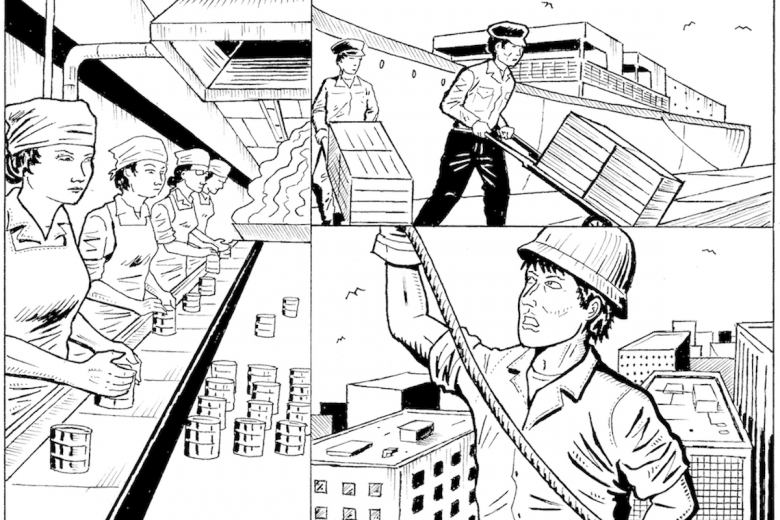Only a day into the strike, when spirits are high and the heat of late summer is still hanging in the air, a group of us – members of the Laurentian University Faculty Association (LUFA) – are walking the picket line at the campus parking lot known as “the pit” when a car pulls up on the side of the road and two young men, smiles as wide as their truck, come toward us with pizza boxes in their hands. They stay long enough to distribute the food and wish us good luck, then get back on the road to take food to another group of faculty picketing up the hill. All week, students turn up with offerings they have bought or made themselves – pizza, muffins, coffee, doughnuts – and every time it seems like a wonderful and surprising turn of events.
On September 29, 2017, LUFA went on strike for the first time since 1989. Their concerns included the right of academics to make decisions about how their departments should be run and staffed, as well as the right to be protected from arbitrary or punitive changes to workload. In their communications with the students and the community, the administration characterized the dispute as one of salaries and pensions, implying that faculty were holding out for more than was fair since they were being offered terms “consistent with those negotiated by faculty at other universities in Ontario in recent months.”
There was nothing surprising about the administration’s attempt to render the dispute in economic terms. There is a rich academic literature on the subject, from Bill Readings’ The University in Ruins and Stefan Collini’s What Are Universities For? to Christopher Newfield’s The Great Mistake, documenting the emergence of a discourse on university education and labour that is saturated with the language of costs, economic viability, and value for money. Administrators increasingly use the language of budgetary constraints, lack of public funding, and increasing costs to explain why students are saddled with debt while conveniently ignoring the fact that the salaries of the top layers of administration continue to grow substantially at the same time that the professoriat has become increasingly precarious.
Data from Statistics Canada and the Canadian Association of University Teachers (CAUT) indicate that academic contract staff numbers across the country have increased by 200 per cent since 1999, while over the same period the number of tenured professors has only increased by 14 per cent. Precarious academic staff cost the university less, in terms of salaries and benefits, and their insecure work conditions mean that they are also less able to resist the erosion of collegial governance – the division of decision-making powers whereby decisions about what to teach and who should teach it are governed by academic considerations rather than calculations about teaching costs and employability.
Arguments that the university should be governed by the logic of the market have cumulative effects on what both faculty and students do on a daily basis.
Arguments that the university should be governed by the logic of the market have cumulative effects on what both faculty and students do on a daily basis. Pedagogically, this has meant a greater emphasis on teaching skills rather than particular content. The idea that a student might be encouraged to pursue a program of study for the sake of being educated has been replaced by the notion that time invested in learning must produce a near-immediate return on that investment in the form of employability or bankable skills – and this occurs while employers shirk their investment in training and professional development. Professors are pushed to demonstrate that what they teach is immediately relevant to helping their students find employment; students are likewise pushed to choose courses that will ensure their future economic success.
Unsurprisingly, then, faculty at Laurentian had a different narrative about the strike than the administration. On social media and in the information handed out at pickets, they explained they would rather be teaching than striking, and that what mattered were the organizational conditions for good education to be in. Nevertheless, in focusing on the students’ concerns about the quality of their education, faculty members were speaking to them as more than economic actors – something that proved to be important as the strike continued. There was nothing especially radical about focusing on the students as the beneficiaries of the strike action, but it also served as an invitation to them to get involved in their education at another level. Where students are protesting tuition hikes, or counting the money they lose during a professorial strike, they are still captured in the idea that their education is somehow outside of them. In this strike, the students were invited into the action and they accepted the call.
The challenge in reframing the economic terms of current thinking about higher education is that the students do increasingly find themselves forced to make complex economic calculations about their education. As soon as the strike began, the City of Greater Sudbury sent a notice to students eligible for their child care subsidy program that however long the duration of the strike, they would not be entitled to the subsidy beyond the end of October 2017. Since the students would not be in full-time education while the strike continued, they were deemed to be ineligible for their means-tested child care assistance. The students were thus placed into a situation where they had to decide what they could afford to do – wait and hope that the strike would resolve by the time they had to give notice to withdraw their child from daycare, or go into debt to keep their children’s hard-won place in the daycare program of their choice.
In the end, it was a combination of student action and community engagement that resolved the problem. The university’s English-language student newspaper, Lambda, ran a short article highlighting the situation, which generated public protest against the city of Sudbury. The city was forced to reconsider its position and by October 2 announced that child care subsidies would be provided to students for the duration of the strike. The student paper’s intervention was an important piece in maintaining student solidarity.
By the beginning of the first full week of the strike, two students from the social work program, Stephanie Brown and Christine Neilsen, had organized a rally in support of the striking professors. At noon on Monday, October 2, 200–300 students, including some who had driven three hours north from the Barrie campus (Laurentian’s failed satellite campus, due to close in 2019), joined the faculty at the main entrance to the Sudbury campus with handwritten signs and banners. Many of the signs were simple messages of solidarity, but some of the more personal signs drew attention to particular concerns and expressed attachment to the faculty.
One notable student sign read, “When admin threatens my mental health, it’s the faculty that keeps me going! Help them help us.” Mental health in universities has made national and international news in recent years because of the dramatic rise in students who are living with debilitating mental health symptoms and conditions. Earlier this year, a joint investigation between the Toronto Star and Ryerson University School of Journalism demonstrated the extent of this mental health crisis across a range of indicators, including increased university mental health budgets as well as a rise in accommodations for students with mental health conditions. A survey by the American College Health Association indicates that between 2013 and 2016, there were notable increases in anxiety (50 per cent), depression (47 per cent), and attempted suicide (47 per cent).
Living conditions under neoliberal education and labour contribute to and amplify poor mental health; these effects are compounded by the fact that mental health services on campuses are over-subscribed and poorly funded.
In many ways, living conditions under neoliberal education and labour contribute to and amplify poor mental health; these effects are compounded by the fact that mental health services on campuses are over-subscribed and poorly funded. In today’s university, where students can be on the waiting list to see a counsellor for weeks, it is often the case that they turn to a faculty member they trust as a stopgap to help them cope with the demands of university life. The student’s sign recognized that relationships with their profs were at the centre of not just their learning, but also their survival while at the institution.
The union and the administration finally reached a tentative deal early in the morning of October 6 that addressed many of the union’s key concerns about collegial governance, workloads, and better job security for contract staff. Whether the administration was surprised by the strength of student support for the faculty, and what part it played in their willingness to return to the negotiating table, is a matter of speculation. There are other factors that contributed to the success of this particular strike in achieving its objectives.
The union membership was strongly behind the strike, giving the bargaining unit a 91 per cent strike mandate before negotiations stalled, and they showed up on the picket lines in impressive numbers to demonstrate their commitment. Sudbury is also a mill town with a labour history, where strikes are both understood and respected. City buses, for example, did not cross the picket lines and only drove around the outer perimeter of the campus. There was strong support from the Laurentian University Staff Union, faculty unions around the province, as well as a flying picket planned, though not ultimately needed, by CAUT.
From a faculty perspective, however, it is clear that the students were an important part of the success of this strike, and it was their actions that gave the lie to the administration’s understanding of all of us, both professors and students, as mere economic actors. Everything the students did – from using their own money to buy the striking profs food, to their explanations of what their education means to them – demonstrated their experience of an actual relationship to the people from whom they were learning.
From a faculty perspective, the students were an important part of the success of this strike. their actions gave the lie to the administration’s understanding of both professors and students as mere economic actors.
The role of student solidarity remains one of the most promising potentials of the Laurentian strike. Laurentian is a special case because the university enjoys one of the lowest student–professor (18:1) ratios in the province. Where student–teacher ratios are higher and there are higher numbers of precarious, contract staff, one might not expect students to demonstrate the same solidarity, not for any reason other than that the pedagogical relationship has already been compromised by neoliberal governance of the university. Some short weeks after the strike at Laurentian ended, the province-wide strike at public colleges across Ontario began and the terms of this strike were very familiar: job security, collegial governance, and academic freedom. The student response to this strike, from the outset, was not as enthusiastic or supportive as it had been at Laurentian. Nevertheless, what the Laurentian strike suggests is that we need to find ways to protect and strengthen the working relationships between professors and students. Maintaining small class sizes; actively organizing with students on issues such as mental health and child care; and involving students in collegial governance are all ways in which this relationship can intervene against the marketization of higher education.
In the scholarly literature on neoliberalism in education, halting the decline of learning conditions involves rewriting the histories of the university, providing economic analyses of debt, and disrupting public rhetoric about education. In the more explicitly feminist and anti-racist literature, there are other narratives that remain attentive to the political potential of teaching. In The Aftermath of Feminism, Angela McRobbie, a feminist cultural critic of neoliberalism, suggests that “pedagogy and learning have become vital spaces of encounter.” As the rhetoric and logic of the market has restructured the university, it has certainly changed the terms on which pedagogy is organized, but the university classroom remains a space in which power is there to be negotiated because it depends on the relationship between students and teachers.
It is never a surprise to a teacher that students are capable of both doing their own analysis of a situation and acting on their own initiative. The surprise here was that, even under conditions of marketization and privatization, the relationship that emerges in a pedagogical situation is a meaningful one, with consequences in the real world. As university administrations look to the future, they should stop to consider the depth and significance of the teaching relationship that faculty and students create. It is not a product for sale, nor the property of the student or the professor; it is instead the profound effect of a real and lived experience of learning and teaching.







